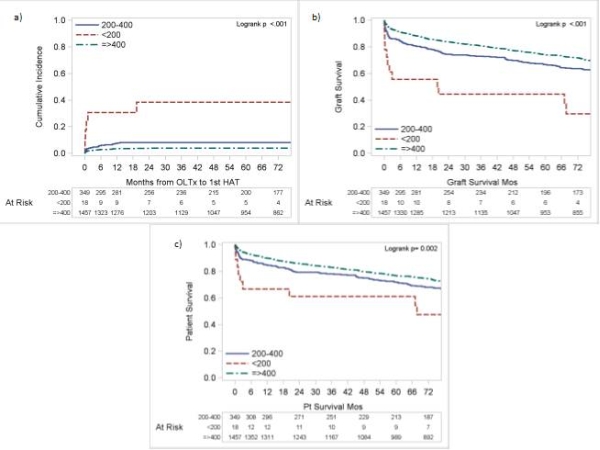Intra-Operative Hepatic Arterial Flow Predicts Hepatic Artery Complications After Deceased Donor Liver Transplantation.
Baylor University, Dallas, TX.
Meeting: 2016 American Transplant Congress
Abstract number: C230
Keywords: Graft survival, Hepatic artery, Liver grafts
Session Information
Session Name: Poster Session C: Liver Transplantation Complications and Other Considerations
Session Type: Poster Session
Date: Monday, June 13, 2016
Session Time: 6:00pm-7:00pm
 Presentation Time: 6:00pm-7:00pm
Presentation Time: 6:00pm-7:00pm
Location: Halls C&D
Introduction
Hepatic arterial flow (HAF) is important for post liver transplant outcomes. This study was conducted to determine the predictive value of measured intraoperative HAF on hepatic artery complications and allograft survival.
Methods
Of 2318 cadaveric liver transplantations performed from 1997-2013, 1823 recipients had complete flow data. They were divided into three groups according to HAF: Group 1 <200 ml/min (n=18), Group 2 200-400 ml/min (n=348), and Group 3 >400 ml/min (n=1457). The primary outcomes measured were hepatic artery complications, and graft survival.
Results
Lower HAF was associated with older donors (table 1). Hepatic arterial complications were highest in Group 1 (44.4%), followed by Group 2 (20%), and Group 3 (13%) (p<0.001, figure 1a) due to the difference in hepatic artery thrombosis (33.3% in Group 1, 7.5% in Group 2, and 3.8% in Group 3, p<0.001). There was no significant difference in the incidence of stenosis (11.1%, 14.3%, 10.3%, p=0.1116). The lowest HAF group had a significantly lower allograft (p<0.001, figure 1b) and recipient survival (p=0.002, figure 1c).
| Variable | Hepatic Artery Flows (ml/min) | P value | ||
| Group 1 <200 ml/min (n=18) | Group 2 200-400 ml/min (n=348) | Group 3 >400 ml/min (n=1457) | ||
| Age (years) | 50.5 (23-66) | 52 (32-66) | 52 (33-66) | 0.235 |
| Donor age (years) | 51 (7-79) | 46 (13-74) | 39 (16-69) | <0.001 |
| Weight (kg) | 83.95 (30-122.7) | 81.3 (50.6-116.8) | 84 (56.8-120.8) | 0.011 |
| BSA (m2) | 1.99 (1.13-2.46) | 1.96 (1.46-2.42) | 2.01 (1.59-2.47) | 0.001 |
| Sex (M:F) | 8:10 | 198:150 | 964:493 | 0.0013 |
| MELD (mean) | 16 (10-40) | 17 (9-40) | 16 (7-36) | 0.031 |
| CIT (hrs) | 7.55 (4.7-11.05) | 7.55 (3.62-12.77) | 7.83 (3.88-13.13) | 0.261 |
| HA flow (ml/min) | 150 (110-180) | 330 (225-389) | 525 (400-930) | <0.001 |

Conclusions
Low HAF is associated with a higher rate of arterial complications, as well as decreased graft and recipient survival after deceased donor liver transplantation. The impact of low HAF is seen almost immediately after transplantation. We recommend HAF measurements in all cases to allow corrective measures to be taken during the transplant to avoid poor outcomes due to arterial complications.
CITATION INFORMATION: Fernandez H, Testa G, Klintmalm G, Kim P. Intra-Operative Hepatic Arterial Flow Predicts Hepatic Artery Complications After Deceased Donor Liver Transplantation. Am J Transplant. 2016;16 (suppl 3).
To cite this abstract in AMA style:
Fernandez H, Testa G, Klintmalm G, Kim P. Intra-Operative Hepatic Arterial Flow Predicts Hepatic Artery Complications After Deceased Donor Liver Transplantation. [abstract]. Am J Transplant. 2016; 16 (suppl 3). https://atcmeetingabstracts.com/abstract/intra-operative-hepatic-arterial-flow-predicts-hepatic-artery-complications-after-deceased-donor-liver-transplantation/. Accessed December 18, 2025.« Back to 2016 American Transplant Congress
